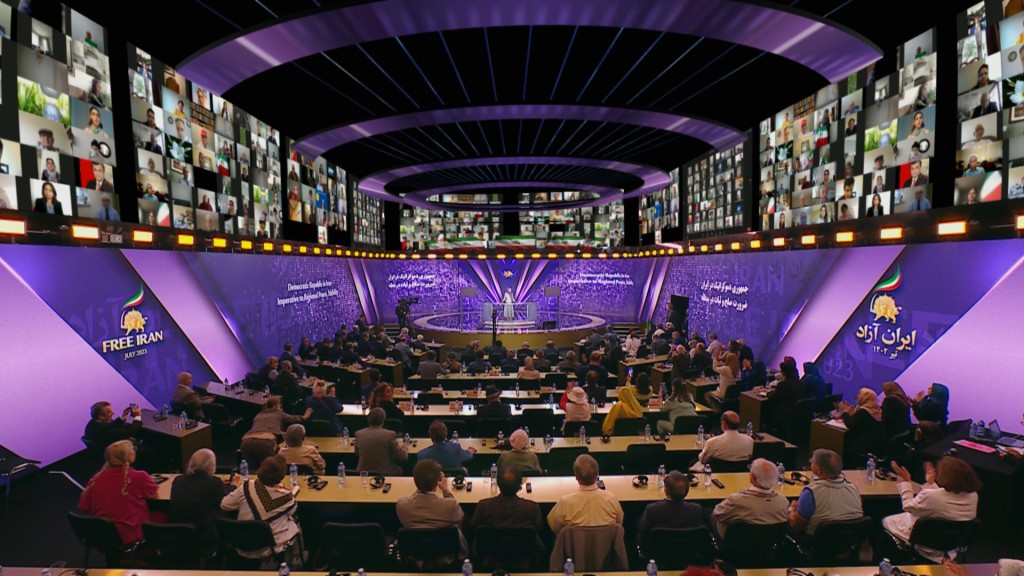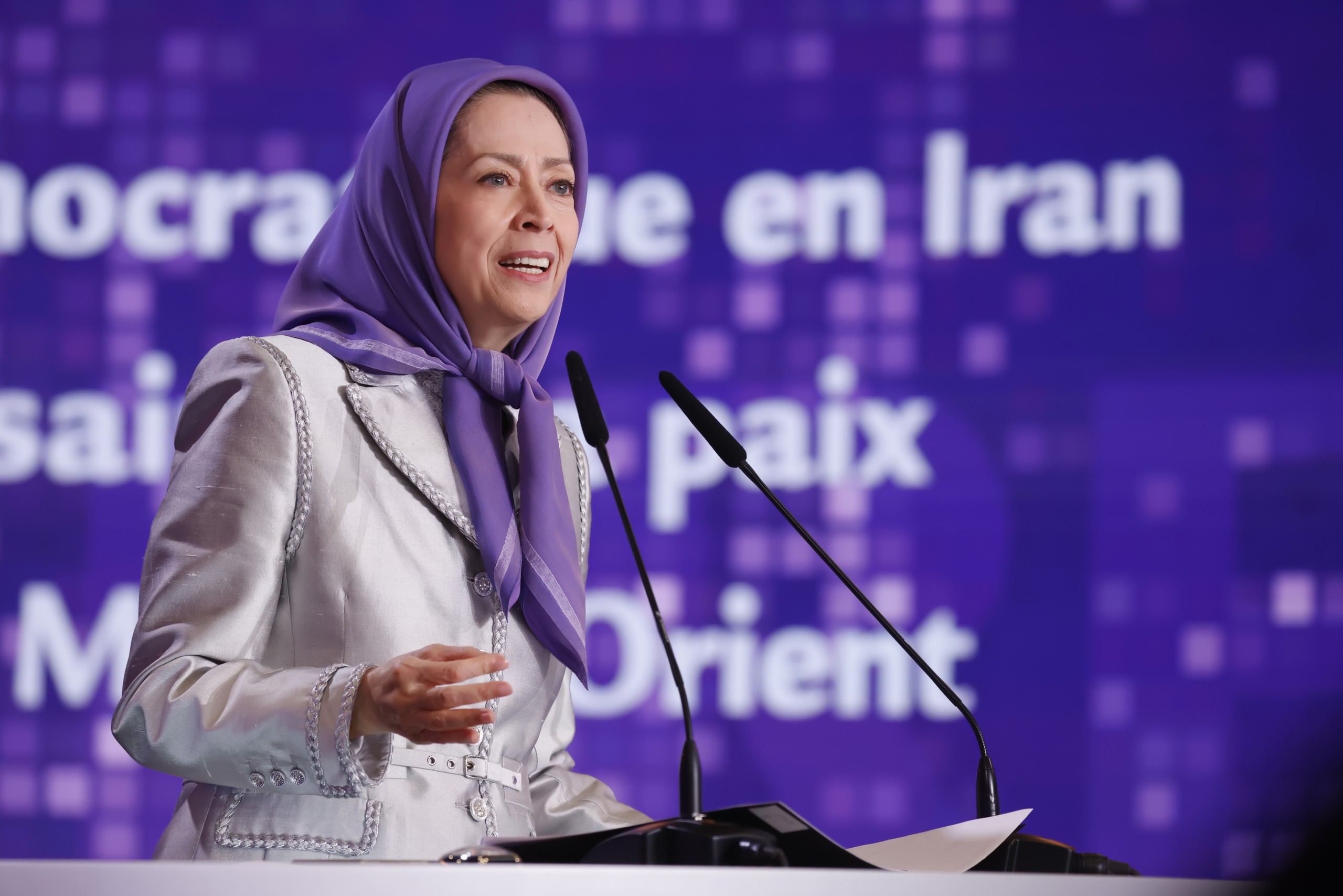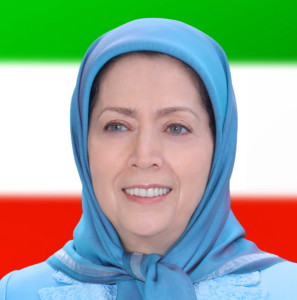Speech by Maryam Rajavi on Day 2 of the Free Iran World Summit

“Democratic Republic of Iran: The Necessity of Peace and Stability in the Region”
Honored Representatives, esteemed friends,
As we convene on the second day of the Free Iran summit, we stand strong amidst a tempest of subterfuge and schemes set forth by Khamenei’s regime. This meeting is a testament to a deep-seated truth of our era. Despite the mullahs’ desperate efforts, they are now unable to further their policies or maintain their grip on power. Undoubtedly, the mullahs’ overthrow is within our reach, and the final victory will indeed belong to the Iranian people and the Resistance.
Velayat-e Faqih, embodying absolute malevolence for people in the region and acting as a fearsome instigator of terrorism and warmongering against the world, is destined to be overthrown, like an arrow set on the trajectory of history. No force can halt this inevitable downfall.
Yesterday, the remarkable participation and immense efforts of supporters of the Iranian Resistance, PMOI members, members of the National Council of Resistance of Iran, representatives from various parliaments worldwide, and prominent political figures, came together to convene the Free Iran World Summit and a rally simultaneously taking place in Paris, leaving a profound impression on the global stage.
This campaign successfully overcame numerous obstacles and formidable barriers. It triumphed over the conspiracies and acts of sabotage carried out by the clerical regime, its accommodators, and collaborators, emerging victorious. It was a magnificent show highlighting the integrity, credibility, legitimacy, and the power of the Iranian Resistance, which stands taller, more prepared, and more determined than ever.
Yesterday, I witnessed extraordinary scenes from the heart of Paris to various gatherings of freedom-loving Iranians and supporters of the Iranian Resistance. At the same time, I received numerous messages from inside Iran that expressed the intense emotions evoked among our compatriots.
I commend those who toil for the Resistance and Revolution. I know you must be tired of the intense efforts during this period, which culminated in the successful event yesterday. But I’m confident that you are more prepared and ready than ever to carry on. I salute all of you who are continuing your efforts today.
Religious tyranny mired in defeats and dead ends
Today, religious despotism finds itself mired in a litany of setbacks and dead ends. From a crumbling economy to internal disputes within the government, a steady stream of departures from the IRGC and Basij, and the nuclear case, the regime is confronted with manifold challenges. Above all, however, its enduring nightmare is the unyielding surge of revolution, which entraps it in a cycle of popular uprisings.
This revolution takes shape through the promotion of a democratic alternative. It manifests in the organized mobilization of defiant and rebellious youth, in the strikes of the Resistance Units on IRGC command centers, and in the ongoing uprising of the people.
Suppression remains the sole instrument and defense strategy of the Velayat-e Faqih regime. However, even this has hit a wall. In the aftermath of the massive unrest of December 2017-January 2018, the regime massacred at least 1,500 youths during the November 2019 uprising. Yet, these brutalities only fanned the flames of resistance and highlighted the legitimacy of the revolutionary solution.
For two years, the clerical regime exploited a human shield of 550,000 compatriots who tragically perished during the COVID-19 pandemic. Despite this, the uprisings reignited in the summer of 2022. The regime responded by murdering at least 750, arresting over 30,000 people, and stepping up executions, which only served to heighten public indignation.
For many years, Khamenei proclaimed that if he didn’t wage war in Iraq, Syria, Lebanon, and Yemen, he would be compelled to erect barricades in Tehran and Isfahan. However, irrespective of the number of atrocities he perpetrates, the extent of his regional interference, or the depth of his strategic alliances, all his efforts are futile. The front line of the conflict, propelled by the momentum of the uprisings, has edged nearer to his own domain, leaving him in anticipation of the final reckoning.
The Regime’s Failed Retrenchment Project
Khamenei envisaged the tightening and retrenchment of his regime as the second phase of the revolution, seeing it as the lifeline for his power. He handpicked loyalists and confidants to command the parliament, while entrusting the presidency to an executioner implicated in the 1988 massacre. Yet, this strategy of retrenchment inevitably collapsed.
Over the past two years, sectors from the cabinet and ministries to industry, banking, and the currency market have experienced unparalleled disruption and instability. Moreover, the ruling regime sought to link its fate and survival to the pursuit of nuclear weapons. However, this plan was doomed from the onset when the PMOI (People’s Mojahedin Organization of Iran) disclosed the regime’s most secretive nuclear facilities.
Indeed, the regime is exerting its utmost efforts, but it cannot eradicate the question of its demise from the Iranian scene. Despite squandering an astronomical 2 trillion dollars against the interests of the Iranian people, even if Khamenei were to manufacture not just one, but a hundred atomic bombs, he would still be incapable of quelling the resolve of the defiant youth involved in the uprising. They assert: “Khamenei, the blood-spiller, we will topple you and lay you to rest.”
Just three weeks ago, Khamenei declared that he deemed the production of an atomic bomb to be in violation of religious and Islamic principles. This reminds us of a fitting proverb in Iranian literature: “Rejoice! The hypocrite has turned preacher, ascetic, and devout!” (Deeds, indeed, speak louder than words.)
We must not forget that Kamal Kharrazi, Foreign Minister under Mohammad Khatami, pledged to British Foreign Minister Robin Cook in front of journalists that the fatwa against Salman Rushdie would not be executed. Yet, the regime never relinquished its pursuit of it.
The Iranian Resistance has clearly stated that “any promise made by the regime to abandon nuclear weapons is both preposterous and void, as the regime regards such armaments as its safety net against the fall of religious fascism.”
Now, we address them: You can beseech appeasing governments as much as you wish to stave off uprisings and democratic alternatives. You can amass arsenals of missiles, drones, and produce bombs to your satisfaction. However, you are cornered and utterly powerless against the most potent and formidable weapon the world has today.
This weapon is the uprising of the people who are resolute in their quest to overthrow the Velayat-e Faqih regime, and they will unquestionably accomplish this.
The PMOI gleaned from their Arab and Palestinian brethren half a century ago that when a nation such as the Iranian people embarks on a path of resistance, endurance, and sacrifices, destiny must heed their calls, the shadows must recede, and the shackles must be broken.

Mojahedin pose the most significant existential threat to the regime
Khamenei strives to acquire bombs, missiles, and what he dubs as strategic depth in the region to shield himself from the most potent and deadly threat to his rule.
Khomeini acknowledged this fact from the outset with his anti-revolutionary intuition. This was illustrated when, responding to Massoud Rajavi’s address at the grand assembly in Amjadieh Stadium on June 25, 1980, he proclaimed, “Our enemy is neither in America, nor in the Soviet Union, nor in Kurdistan, but right here before our eyes in Tehran. Hypocrites! (Referring to the Mojahedin) have declared war against us under the guise of Islam, the Quran, and Nahj ol-Balagha.”
Even today, the regime’s highest authorities and institutions are plagued by sleepless nights due to the Mojahedin, who continue to pose the greatest threat to their dominion.
Just a week ago, the speaker of the mullahs’ parliament referred to the police force’s entry into Ashraf 3 as the pinnacle of the regime’s power. The regime’s mouthpieces openly confess that the Mojahedin topic is brought up in every meeting with European ambassadors or delegations.
The Iran newspaper, an affiliate of Raisi, expressed a wish that the regime could “disrupt the Mojahedin’s network inside Iran” because the uprising’s “leadership, both physically and in the digital sphere,” resulted from the collaboration between the people in Iran and the PMOI.
Internal documents from the regime’s Ministry of Foreign Affairs concede that the Mojahedin possess unity, an organized structure, and significant intelligence capabilities. They are actively striving to topple the regime by forming Resistance Units, positioning them as the only organization with the potential to present an alternative platform.
In recent days, Khamenei’s Friday prayer leaders plainly declared that the recent covert meetings between the regime and American and European officials revolved around negotiations regarding the PMOI/MEK.
As per the mullahs’ accounts from these private meetings, the French government, due to geopolitical considerations, called off the Iranian Resistance’s rally in Paris. This admission attests to the fact that the Iranian Resistance’s rally, thousands of kilometers away from Iran, is a disruption to the mullahs’ geopolitical posture. And indeed, this is the case.
Clerical regime suffers fundamental setbacks from the Mojahedin
The clerical regime has suffered significant setbacks in numerous strategic, political, and ideological areas, at the hands of the Mojahedin and the Iranian Resistance. I will briefly touch upon these setbacks here:
Firstly, the Mojahedin have successfully preserved and propelled the organized movement aiming to overthrow the regime, both within and outside Iran’s borders. They have thwarted countless plots and assaults orchestrated by the regime.
Secondly, despite Western governments efforts to appease the religious fascism and their remarkable efforts to fabricate fake alternatives, the overwhelming majority of elected representatives in America and Europe, including France and the UK, have expressed support for the Iranian people’s aspiration for a democratic republic. They have also endorsed the Ten-point Plan proposed by the Iranian Resistance.
Thirdly, the Mojahedin have positioned themselves as the antithesis to religious fundamentalism and have ideologically defeated the ruling regime by advocating for a democratic interpretation of Islam, especially in terms of gender equality.
For nearly four decades, women across all strata of this movement have led and managed affairs, deriving lessons from priceless and often blood-soaked experiences. Alongside them is a generation of men who have willingly embraced gender equality and demonstrated it in practice. The PMOI’s Central Council comprises 1,000 committed women who have bravely weathered various trials and tribulations, ranging from incarceration by the regime to the battlegrounds.
In the battle against Khomeini and his regime, tens of thousands of Mojahed women gave their lives, withstood imprisonment, and experienced torture. In light of this history, today’s brave Iranian women and girls assume leadership roles on the frontlines, confronting the regime’s guards.
Iranian women have resolved to overthrow the largest religious dictatorship in history. Indeed, what resource could be more valuable, potent, and efficient than this in achieving freedom, democracy, and equality?
For this reason, the regime and its IRGC guards live in continual fear of this resistance and its leading women, whether in the cities and streets of Iran, Ashraf 3, or anywhere globally.
Dear friends,
The three factors I have outlined are the primary reasons why the mullahs have sought to secure the backing of Western governments in suppressing the Iranian Resistance. However, the Iranian Resistance is deeply embedded within Iranian society. It has proudly emerged from four decades of assaults, plots, and demonization, and continues to defeat and foil the regime’s desperate attempts.
As Massoud Rajavi has articulated: “The National Council of Resistance and the People’s Mojahedin Organization of Iran are not like rootless weeds; they are legitimate and have arisen from the depths of our country’s struggles and history. They are the true heirs to our people’s most authentic traditions and battles, standing at the pinnacle of evolution today. At this crucial juncture, we proclaim a magnificent certainty and a shining truth: the overthrow of the clerical regime and the inevitable triumph and liberation of the Iranian people.”
A united front against the Velayat-e Faqih regime and fundamentalism under the name of Islam
Now, I wish to address all Islamic nations and Muslims of various faiths and beliefs. While it is true that the people of Iran were the first victims of the oppressive Velayat-e Faqih regime, it is crucial to acknowledge that this regime is the greatest enemy of Islam and Muslims. Fundamentalism and terrorism under the banner of Islam, whether Shiite or Sunni, are either promoted and financed by the regime, or have their origins in the regime.
The policy of appeasement towards this regime has not only harmed the Iranian people, its primary victims, but has also had disastrous consequences for the entire region and our Arab and Muslim brothers and sisters.
In the presence of esteemed representatives and elected officials from around the globe, I call on all Middle Eastern countries, Islamic nations, and Muslims to show solidarity with the people of Iran and form a united front against the Velayat-e Faqih regime and fundamentalism disguised as Islam.
The era of oppressive rule under the Shah and the mullahs, characterized by the suppression of revolutions and oppressed movements in Iran, came to an end in the 14th century (in the solar calendar). A hundred years of monarchy and religious tyranny, marked by countless crimes, have been more than enough.
Now, as we enter the 15th century, let it be defined by the name of the Iranian people, the Republic, and the democratic revolution of Iran. This revolution promises freedom for the Iranian people, and peace and security for the region and the world.
May God bless you all
- Tags: Free Iran, fundamentalism, MEK, NCRI, Women

